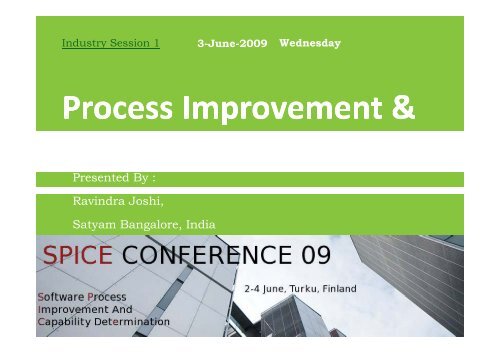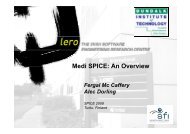Presented By : Ravindra Joshi, Satyam Bangalore, India
Presented By : Ravindra Joshi, Satyam Bangalore, India
Presented By : Ravindra Joshi, Satyam Bangalore, India
You also want an ePaper? Increase the reach of your titles
YUMPU automatically turns print PDFs into web optimized ePapers that Google loves.
Industry Session 1 3-June-2009 Wednesday<br />
<strong>Presented</strong> <strong>By</strong> :<br />
<strong>Ravindra</strong> <strong>Joshi</strong>,<br />
<strong>Satyam</strong> <strong>Bangalore</strong>, <strong>India</strong>
IIndex d<br />
Current world view<br />
EExample l of f innovation<br />
i ti<br />
Overview of Improvement v/s innovation<br />
Differences in Improvement v/s innovation<br />
Innovation lifecycle<br />
Brain – complementary roles<br />
Mindmaps , example<br />
Summary<br />
Points to ponder<br />
3-June-2009 SPICE09-<strong>Ravindra</strong> <strong>Joshi</strong> on Innovation<br />
2
Primary need of innovation : Products itself<br />
newer features/characteristics – so as to better align with end<br />
users’ requirements,<br />
more environment friendly,<br />
lleveraging i latest l technological h l i ladvances, d<br />
more safe & reliable operation,<br />
ease of installation; assembly; upgrade or replacement etc. etc<br />
Secondary need of innovation : Process for products<br />
differentiating g with competition, p<br />
better packaging,<br />
faster time‐to‐market,<br />
attractive branding; promotion; advertising etc.<br />
HHowever , above b are IImprovements, not IInnovation i !<br />
3-June-2009 SPICE09-<strong>Ravindra</strong> <strong>Joshi</strong> on Innovation<br />
3
Live , stationary<br />
Theater,<br />
operas<br />
&<br />
concerts<br />
Remote, still limited<br />
movement<br />
Vacuum tube<br />
Radio,<br />
GGramophone h<br />
record player<br />
Transistor<br />
radio,<br />
magnetic<br />
tapeplayers<br />
Remote Remote, movable freely<br />
minicassette<br />
players,<br />
mini-disc,<br />
CD players p y<br />
3-June-2009 SPICE09-<strong>Ravindra</strong> <strong>Joshi</strong> on Innovation<br />
4<br />
MP3 USB<br />
player,<br />
Go-Gear<br />
Walkman
Improvement Innovation<br />
survival strategy market leadership/thriving strategy<br />
exploit existing technology explore new technology<br />
low uncertainty High uncertainty<br />
focus on cost or feature improvements in focus on products, process or services<br />
existing product, process or services with unprecedented performance<br />
features<br />
Evolutionary approach –next level needs Revolutionary approach ‐<br />
earlier level to build on leapfrogging/quantum shifts<br />
improve competitiveness within current<br />
market or industries<br />
create a dynamic change to transform<br />
existing markets or industries, or creates<br />
new ones<br />
3-June-2009 SPICE09-<strong>Ravindra</strong> <strong>Joshi</strong> on Innovation<br />
5
Incremental Radical<br />
Emphasis Cost or feature improvements in Development of new businesses, products<br />
existing products, services, or and/or processes that transform the<br />
processes<br />
economies of a business<br />
Technology Exploitation of existing technology Exploration of new technology<br />
Prototyping Ironing out wrinkles near the end of Teaching the market about the new<br />
the design phase technology and learning from the markets<br />
how valuable that technology is in that<br />
application arena<br />
Trajectory Linear and continuous Sporadic and discontinuous<br />
Business Case Detailed plan can be developed at Business model and plan evolves through<br />
the beginning of the process discovery‐based learning<br />
Idea Generation &<br />
Occur at the front end; critical events Occur sporadically throughout the life cycle,<br />
Opportunity Recognition are largely anticipated<br />
often in response to discontinuities in the<br />
project trajectory<br />
Key Players Formal cross‐functional teams Cross‐functional individuals, informal<br />
networks<br />
Process Formal, phase‐gate model Informal, flexible model at early stages due<br />
to high uncertainties → formal at later<br />
stages after uncertainties have been<br />
reduced<br />
Organizational Structures Cross‐functional project team Project starts in R&D → migrates into an<br />
operates within a business unit incubating organization → transitions into a<br />
goal‐driven project organization<br />
Resources and competencies Standard resource allocation; the Creative acquisition of competencies and<br />
team has all competencies required resources from a variety of internal and<br />
to complete p the pprocess<br />
external sources<br />
Operating Unit Involvement Formal involvement from the very Informal at early stages → formal at later<br />
beginning<br />
stages<br />
3-June-2009 SPICE09-<strong>Ravindra</strong> <strong>Joshi</strong> on Innovation<br />
6
successful<br />
prototypes can<br />
be taken up to<br />
productization<br />
proof‐of‐concepts, rapid<br />
prototyping, sandboxes,<br />
skunkworks<br />
implementation<br />
experimentation<br />
Origination<br />
Evaluation<br />
Capture<br />
brainstorming, mindmapping,<br />
ideation sessions, suggestion<br />
schemes, campaigns,<br />
Structured lateral thinking<br />
techniques like six‐thinking<br />
hats etc<br />
documented,<br />
refined further<br />
and<br />
filed/classified/ta<br />
gged<br />
comparing potential of ideas with<br />
expected outcome, few are<br />
shortlisted<br />
3-June-2009 SPICE09-<strong>Ravindra</strong> <strong>Joshi</strong> on Innovation<br />
7
LEFT BRAIN FUNCTIONS RIGHT BRAIN FUNCTIONS<br />
uses logic uses feeling<br />
detail oriented "big picture" oriented<br />
facts rule imagination rules<br />
words and language symbols and images<br />
lfb left brain right h bbrain present and past present and future<br />
dominates rational,<br />
logical, incremental<br />
thoughts<br />
thoughts can only<br />
proceed further<br />
with a known<br />
context, limits<br />
applications to<br />
certain boundaries<br />
needs text &<br />
alphabetical<br />
notations for<br />
capturing thoughts<br />
Views world in<br />
inspires ideas,<br />
natural insights<br />
can imagine<br />
unknown entities,<br />
not limited in any<br />
frame of reference<br />
uses pictures,<br />
relations and<br />
associations to<br />
consolidate ideas<br />
Visions world as<br />
compartments, with whole common,<br />
certain depth with ample breadth<br />
linear thinking lateral thinking<br />
math and science philosophy & religion<br />
can comprehend can "get it" (i.e. meaning)<br />
knowing believes<br />
acknowledges appreciates<br />
order/pattern<br />
perception<br />
spatial perception<br />
knows object name knows object function<br />
reality based fantasy based<br />
forms strategies presents possibilities<br />
practical impetuous<br />
safe risk taking<br />
3-June-2009 SPICE09-<strong>Ravindra</strong> <strong>Joshi</strong> on Innovation<br />
8
Mindmaps:<br />
hhelps l us pull ll together h and d organize i all ll our thoughts h h for f any<br />
theme<br />
easy way ay to capture captu e as well e as ppresent ese t information o at o<br />
a visual way of organizing ideas in a web like structure<br />
perfectly correlate with the way our minds actually work ii.e. e<br />
we do not think in lists or long essays; we think in images and<br />
key themes, shapes and patterns - all connected one to<br />
another<br />
The originator of Mindmaps :Tony Buzan, author & an educational<br />
consultant, propounded Mindmapping technique in year 1960.<br />
Buzan developed Mindmapping whilst at University, out of the<br />
frustration that traditional notes took up so much time to create<br />
and review. He argued that Mindmaps are an efficient way to take<br />
notes from lectures or books.<br />
3-June-2009 SPICE09-<strong>Ravindra</strong> <strong>Joshi</strong> on Innovation<br />
9
3-June-2009 SPICE09-<strong>Ravindra</strong> <strong>Joshi</strong> on Innovation<br />
10
This paper has attempted to demystify Innovation by<br />
clearly differentiating between improvement over<br />
existing v/s creating newer products. It outlines<br />
bbriefly i fl th the role l of f llateral t l thi thinking ki as major j pillar ill to t<br />
fueling innovation.<br />
Mi Mindmapping d i can be b utilized tili d as an effectiveness ff ti tool t l<br />
that can improve our ideation, and in turn contribute<br />
to innovation.<br />
3-June-2009 SPICE09-<strong>Ravindra</strong> <strong>Joshi</strong> on Innovation<br />
11
Currently many innovations are funded & leveraged for<br />
purpose of maximizing business/financial benefits of<br />
and for few. few Reason behind this paradigm is fixated on<br />
amassing large quantities of material wealth – money,<br />
land, gold etc<br />
While we cannot deny or ignore necessity of material<br />
wealth – we also need leverage Innovation much more<br />
towards higher humane dimensions e.g.<br />
green and clean earth,<br />
health for all (esp. underprivileged),<br />
literacy & employment for all (esp. developing nations in<br />
Africa & Asia),<br />
merging of national/regional/language boundaries towards<br />
uniting humankind against terrorism & trade<br />
protectionism and<br />
Leaving an exciting future for our coming generations.<br />
3-June-2009 SPICE09-<strong>Ravindra</strong> <strong>Joshi</strong> on Innovation<br />
12
Questions ??<br />
ravindrabjoshi@gmail ravindrabjoshi@gmail.com com<br />
3-June-2009 13<br />
SPICE09-<strong>Ravindra</strong> <strong>Joshi</strong> on<br />
Innovation








